#tasmanian pademelon
Explore tagged Tumblr posts
Note
Trick or treat!!!

Happy Halloween, longtime follower! I hope you like your Tasmanian pademelon!
(img src)
27 notes
·
View notes
Text

Tasmanian pademelon (Thylogale billardierii) portrait, Cradle Mountain National Park, Tasmania, Australia.
Photographer: Suzi Eszterhas
#suzi eszterhas#photographer#tasmanian pademelon#thylogale billardierii#cradle mountain national park#tasmania#australia#animal#mammal#wildlife#nature
26 notes
·
View notes
Text

Marsupial Love 💗🦘
#my art#kemono friends#Pademelon#Tasmanian Devil#Eastern Quoll#Tumblr logged me out when I tried to post this????#anyways I thought it'd be cute to pair these three up since Tasmanian Devil and Eastern Quoll are predators to Pademelon#What if they fought over her though yknow
7 notes
·
View notes
Text




#poll#Class: Mammalia#Order: Diprotodontia#Family: Macropodidae#Genus: Thylogale#Thylogale Billardierii#Range: Australasian
29 notes
·
View notes
Text
#2793 - Sarcophilus harrisii - Tasmanian Devil

One of the... interesting ... examples of taxidermy in the Victorian-style wing of the Otago Museum. I have no idea what they did to the poor thing to make it look like that. Soaked it in bleach perhaps? They're SUPPOSED to look like this -

(Photo by JJ Harrison, Wikipedia)
Or possibly this.

Anyway - originally described in 1807, by George Prideaux Robert Harris, deputy surveyor and naturalist in Van Dieman's Land (later Tasmania) from 1803 until his death there 7 years later. He called it Didelphis ursina, thinking it was an opossum with bear-like ears. However that binomial had already been applied to the common wombat - also not an opossum, and renamed Vombatus ursinus later anyway. In 1838, it was named Dasyurus laniarius by Richard Owen (a very skilled zoologist but GIGANTIC asshole) but he later put it in it's own genus Sarcophilus. The current binomial mean's "Harris's flesh-lover") and was coined by French naturalist Pierre Boitard in 1841.
Other names have included purinina, in palawa kani, "Beelzebub's pup", Sarcophilus satanicus ("Satanic flesh-lover") and Diabolus ursinus. The animals did NOT have a good reputation among their European settlers, who were unnerved by the hideous screaming at night, and an perceived threat to livestock.
The largest surviving carnivorous marsupial, after the extinction of the Thylacine (another much-maligned marsupial imagined to be a threat to sheep). Males are usually larger than females, with an average head and body length a little over 65cm (25.7 in), and an average weight of 8 kg (18 lb).
Carnivores and carrion feeders, mostly active at night, and not particularly territorial unless they're a female defending their den. Home ranges are estimated to vary between 4 and 27 sq.km., depending on how many wallabies and pademelons live in the area. They can take down prey as large as a small kangaroo, and favour wombats, but also eat wallabies, bettong and potoroos, echidnas, water rats, domestic mammals (including pets, rabbits and the legs of sheep that have slipped between the floorboards in wooden shearing sheds, leaving their legs dangling below), birds (including penguins), fish, fruit, vegetable matter, insects, tadpoles, frogs and reptiles, but carrion remains the bulk of the diet. Near human habitation, they can also steal shoes and chew on them.
They can eat up to 40% of their body weight in 30 minutes, so carcasses around farms tend not to last long. Quite a handy clean-up service, as far as the farmers are concerned. The notorious shrieking and growling occurs when multiple Devils (up to twelve) converge on a carcass and sort out who gets to eat first.
Devils are now only found on the island of Tasmania, although they and two other species once existed on the mainland. Threats to their survival include a bounty paid for their extermination between 1830 and the 1930s, but after the extinction of the Thylacine in 1936 moves were finally made to protect them. Vehicle collisions are also a serious problem. More recently, Devil facial tumour disease, a transmissible cancer that the Devils catch off each other when squabbling and biting, has become an extremely serious problem, with tumour-free populations becoming dangerously inbred.
Otago Museum, Dunedin, Aotearoa New Zealand, Tasmanian Devil,
#Otago Museum#Dunedin#Sarcophilus#tasmanian devil#Dasyuridae#marsupial#carnivorous marsupial#bad taxidermy#Dunedin NZ
3 notes
·
View notes
Text
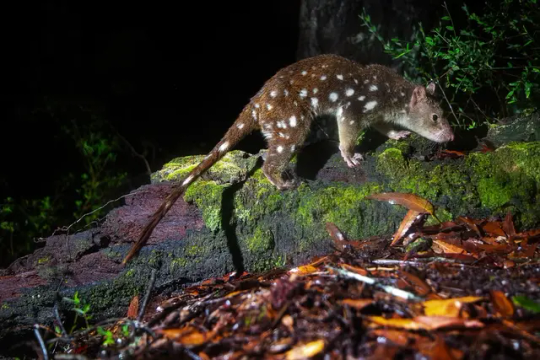
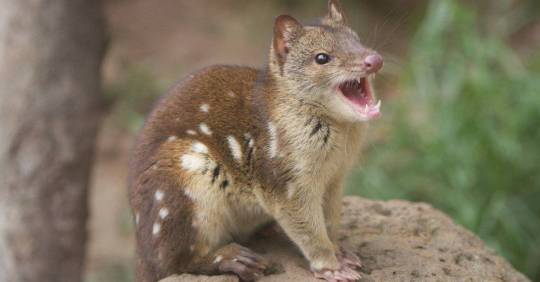
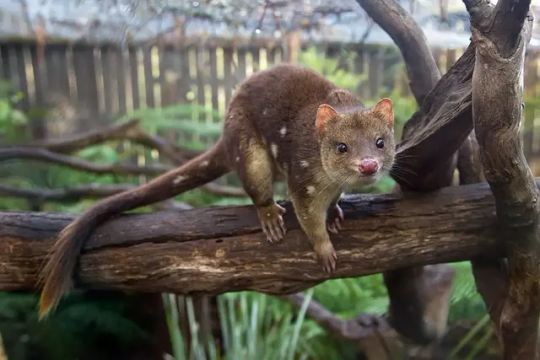
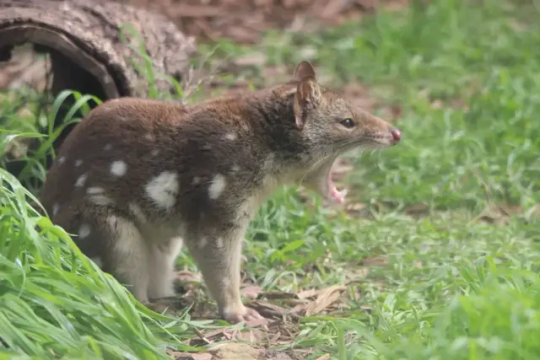
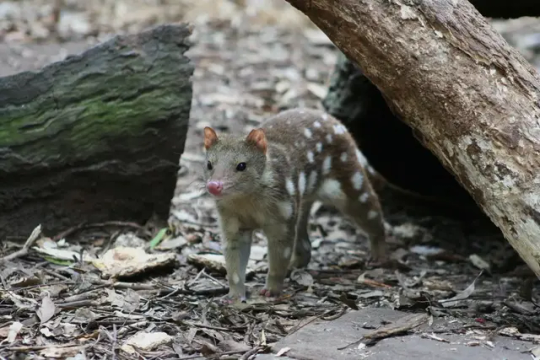

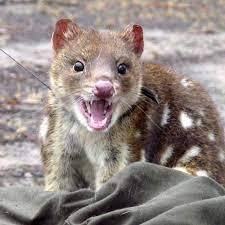

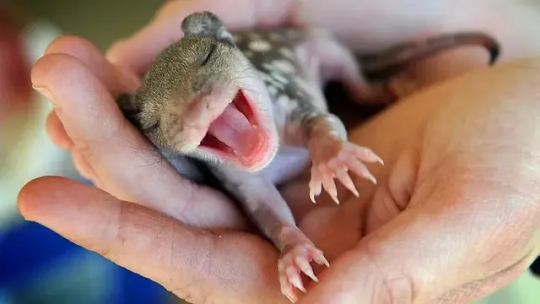
Dasyurus maculates, better known as the tiger quoll, the spotted-tail quoll, the spotted quoll, the spotted-tail dasyure, native cat or the tiger cat, is a carnivorous marsupial native to eastern and southern Australia and the island of Tasmania. These semi-arboreal mammals can be found in a variety of habitats including mixed dry and alpine forests, pastureland, and grasslands, but seem to prefer wetter environments such as riverine forests, rainforests and closed eucalypt forest. Tiger quolls are generally nocturnal, spending there days in dens they build in burrows, caves, rock crevices, tree hollows, hollow logs, or abandoned buildings. They emerge at night to hunt prey such as insects, crustaceans, lizards, snakes, frogs, birds, platypus, echidnas, rabbits, possums, cuscuses, gliders, bandicoots, pademelons, small wallabies, and wombats. Tiger quolls are themselves preyed upon by Tasmanian devils, masked owls, dingos, large pythons, and wedge-tailed eagles. Reaching around 27 to 45 inches (69 to 113cms) in length and 3 to 15lbs (1.3 to 7kgs) in weight, with females being a far bit smaller than males, the tiger quoll is the second largest carnivorous marsupial on earth after the Tasmanian devil. At 308 newtons the tiger quoll also sports the second most powerful bite relative to body size of any living mammalian carnivore, after the Tasmanian devil. The tiger quoll has relatively short legs, a tail as long as the rest of its body, a thick neck, and large head with an elongated rounded snout. Each foot has 5 toes with pink foot pads are ridged, an adaptation for its arboreal lifestyle. The fur is typically reddish brown, occasionally black, with a creamy white colored underside. Mating occurs from april into july. The gestation period in this species lasts for 21 days, yielding 5 young on average. The babies are then moved to the pouch of their mother, where they continue to grow for the following 12 weeks. The young become fully independent by 18 to 21 weeks of age, reach sexual maturity at 1 year, and may live up to 7 years.
#pleistocene pride#pleistocene#pliestocene pride#pliestocene#cenozoic#australia#tasmania#tiger quoll#marsupial#quoll
14 notes
·
View notes
Photo
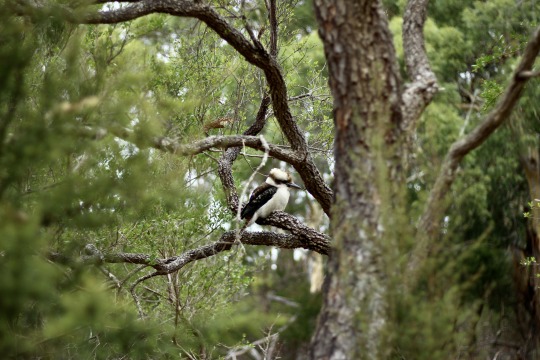


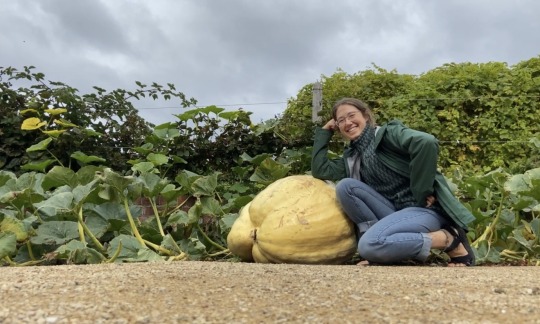






Week 7: March 27th – April 2nd, 2023 // Final Count Down
It’s been such an eventful roller coaster this week! Nearing my final days in Tassie I’ve been wrapping up loose ends for van things, making an effort to check off some of the final main “must-sees,” and trying to make the most of my remaining time here. It’s been a rather emotional one if I’m being honest. The reality of me venturing off properly on my own is setting in and I’d be lying if there wasn’t a lot of anxieties coming with it. Between the usual worrying I’ll forget something important, to the unknown adventures and mishaps, to the general lack of expertise in so many things. I feel as though I’m throwing myself into the deep end, and while I’m SO incredibly excited for what has been a dream of mine for years to finally become reality, there’s a healthy amount of “what the fuck am I doing” to keep me grounded? Level-headed? Who knows lol.
--
We kicked off this week with a true Tassie must experience! I brought my car out to a mechanic in Triabunna to get some work done [stuff required for the safety certificate I needed – I’m going to do a whole separate post dedicated to buying a vehicle in Australia], which was coincidentally just a 10minute walk to the ferry that’ll take you to Maria Island! Maria Island is infamous for its abundance of wildlife (Wombats, Kangaroos, Wallabies, Pademelons, etc.) and endless trails for walking and biking. I mentioned the details in a recent Instagram post https://www.instagram.com/p/CqVZbZvyTO2/ but the island doesn’t allow cars, making it an absolute dream space to properly disconnect and venture into nature (keep an eye out for a detailed post on Maria Island in the future). Most of the island doesn’t get much service either so it really does force you to be present with your surroundings. I turned my phone on airplane mode and used the little paper map from the information centre to get around, using mostly just my camera for capturing little moments.
The weather was perfect, mostly overcast but warm, with few breaks of sun. My favourite moments from this day were wandering across the beach and the painted cliffs barefoot for about an hour – just taking time to really admire the beauty of the naturally formed patterns –
getting to sit with a wombat, and capture a really beautiful photo of a kookaburra.
Unfortunately for the van, one of the parts ordered didn’t arrive… so we were left to hope the mechanic back in Hobart would give me the safety certificate anyways…
--
Plot twist… they did!! Tuesday I called them up first thing to see if they could change my appointment to meet with me that day (the girl I bought the van from was leaving the next day for a 9-day trip, so this was quite literally our last chance to get everything officially and properly signed over to me). Brought it in and 2 hours later was handed the safety certificate! It was a super rainy day, so I spent most of it curled up in the van outside the Fitzy Castle house, working on blogs, editing my photos from Maria Island, working out some plans for my final week. Taking it relatively easy after the big win.
--
Wednesday is once things really started to kick into gear. Met up with Stefi (the girl I bought Peg from) in Sorrell to get the registration moved to my name, transferred from Queensland to Tasmanian plates, and get a Tasmanian drivers licence! I think the woman at Service Tassie had a good laugh at us – she made a comment about how it seemed so funny to be so stoked about getting new plates and a driver’s licence – all we could really say was that it had been such a long time coming to get to this point! Honestly, everything else for this trip has been so seamlessly smooth – I’ve been lucky to have made some really incredible connections for all aspects of my trip, the support I’ve received here has gone well above anything I could’ve ever expected – but the process for getting the van actually put in my name has for sure been as nail-biting as you could get it. Quite literally got drawn out to the last possible second, but SO thankful it all worked out!
I’d been in need for a good climb, so once I got settled back, had some food, I took myself to the gym for a good boulder sesh. It’s been so cool and motivating seeing the progression I’ve been making in my strength and technique. Working through routes I would never even be attempting back home, even at my strongest. I feel a different level of confidence building up this time around, which has been a lot of fun to navigate and witness.
Spent the rest of the evening + afternoon applying to Sea Shepherd’s volunteer photographer position. I got really into it and ended up putting together a proper portfolio, which got me really excited and eager to look into more work and potential opportunities similar to this. Maybe even some blogging for another company! (Any takers?)
--
Thursday morning, I finished up and sent off the application, then made my way to the MONA (Museum of New and Old Art). I had been told it was a cool experience, but this well exceeded my expectations. For starters, the grounds and architecture are absolutely stunning! So much thought went into not just a place to hold art, but to physically experience it too from the inside and the outside. All your senses are activated when you walk through. You begin by going down 3 or 4 floors underground, and the rest I’ll leave to you to have to experience yourself one day. Let’s just say, I’ve spent a lot of time in museums, especially in Europe, and I think this is my favourite by a long shot.
After eating some lunch and hanging in the van in the MONA parking lot while the rain went past, I made my way to the Royal Tasmanian Botanical Garden’s. It’s quite similar to the UBC Botanical Garden’s but is free to park and enter, and a bit smaller. Super stunning layout and plant life, with lots of really beautifully detailed + informative little signs scattered throughout the park. My favourites were the signs sharing how indigenous people use the plants for materials, medicine, etc.
--
Friday was SUCH a great day. Leah and I had been meaning to connect for a while so we spent the day out at Port Arthur’s visiting the Tasmanian Devil Unzoo, hiking Cape Raoul, and hitting up the infamous ‘Trout Party’ back in Hobart!
I was really impressed with how the Unzoo was set up. The place is meant to help protect Devil’s from contracting the illness that spread like wildfire and wiping out I think something like 95% of the population. Thanks to efforts like theirs, the Devil’s have been rescued from extinction, but still have a long way to go to no longer be considered endangered. Check out the Unzoo website for more information: https://tasmaniandevilunzoo.com.au/save-the-devil/.
Cape Raoul was a beautiful 15.5km hike out to stunning cliff face views, similar to those of Cape Hauy, but with a lot less “up down.”
For those wondering what a ‘Trout Party’ is – one of the houses in the friend has a little bar room that is decked out to be the ultimate “fisherman bar.” It’s just a small room off the backyard with exactly what you’d imagine! This house is known for throwing some pretty fun parties at least a couple times a year, so everyone looks forward to them!
--
Saturday I managed to get in a bit of a slower morning before spending the whole afternoon with Rhys working on the van. The van build has been such a fun learning process, getting to use power tools, brainstorming designs, figuring out ways to make the most use of our material, the many… many… trips to Bunnings (Australia’s version of a Home Depot), seeing my little home come together. Slowly but surely. We had a few little hiccups with the original electrical set up, but thankfully the owner of the house we’ve been using to build out of is an electrician and was super willing and eager to help get it back up and running. I’ve actually really enjoyed the electrical part a lot. It makes me more excited about the idea of designing a proper van from scratch in the future – one with a functioning sink and shower, and lights on dimmers, with electrical outlets. Actually use my schooling for once lol.
--
Sunday I made a point to get out to the Farmgate market one last time. I really didn’t take advantage of the markets back home, and I know this is something I want to be doing more of. Supporting the small local businesses, buying your produce for the week, trying new products, gathering with friends to sit in the park or going solo and wandering leisurely.
The afternoon was spent much more of the same – meeting with Rhys thinking it was our last day of building, just to find ourselves saying “we probably only need a few more hours tomorrow.” We definitely made really good progress today though! It was actually coming together – all the drawers fit together (like a glove I might add… every millimeter really does count) and screwed down into the van, electrical fully up n running, fridge properly set up. The end is truly near…
Then spent the evening hanging out with the house + Sophie for dinner and watching an episode of Alone; this year’s season is filmed here in Tassie!
--
The final days have me feeling a whirlwind of emotions, but overall, I’m feeling incredibly grateful for my time and experiences I’ve had. It turned out to be so much more than I could’ve imagined. The people I’ve met and the support I’ve received has been truly wonderful. Now I move into the last days of preparing to leave for the official big adventure, with no one but myself and Peg. It’s a journey I’ve longed for years, and now… here we are.
Wish me luck.
Stay passionate and curious, Hunter♡
04/03/2023
2 notes
·
View notes
Text
Discovering Tasmania's Unique Wildlife: A Haven for Biodiversity
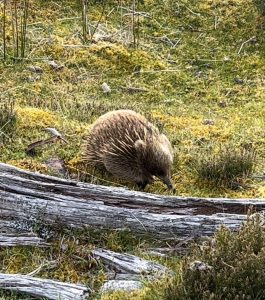
Tasmania, Australia’s island state, is a treasure trove of diverse and unique wildlife. Isolated from the mainland for thousands of years, Tasmania boasts a rich ecosystem filled with endemic species, fascinating habitats, and thriving biodiversity. This makes it a paradise for nature enthusiasts and Wildlife in Tasmania conservationists alike.
Endemic Wildlife
Tasmania is home to several species found nowhere else on Earth. The iconic Tasmanian devil stands out as the most famous. This small, carnivorous marsupial is known for its distinctive screech and powerful bite. Although its population has faced significant threats from Devil Facial Tumor Disease (DFTD), conservation efforts are ongoing to protect and rehabilitate this unique animal.
Another remarkable species is the Eastern quoll, a nocturnal marsupial with spotted fur. Once extinct on the Australian mainland, it thrives in Tasmania’s relatively predator-free environment. The Tasmanian pademelon, a small, wallaby-like marsupial, also calls the island home, adding to its list of endemic mammals.
Birdlife
Tasmania’s bird population is equally remarkable. The island hosts 12 endemic bird species, including the strikingly beautiful green rosella and the Forty-spotted pardalote, one of Australia’s rarest birds. Coastal areas provide sanctuary for seabirds like albatrosses and petrels, while wetlands support migratory shorebirds.
The endangered orange-bellied parrot, one of the world’s rarest parrot species, breeds exclusively in Tasmania’s remote southwest. Efforts to conserve this critically endangered species include habitat protection and breeding programs.
Marine and Aquatic Life
Tasmania’s waters are teeming with marine life. The southern coastline’s kelp forests serve as vital habitats for species such as seahorses, lobsters, and abalone. The Tasmanian coastline is also a prime spot for observing seals, dolphins, and migrating whales, including humpback and southern right whales.
Freshwater ecosystems, including rivers and lakes, are home to the unique Tasmanian giant freshwater crayfish, the world’s largest freshwater invertebrate. Trout fishing is also popular, attracting anglers from around the globe.
Threats to Wildlife
Despite its abundance, Tasmania’s wildlife faces challenges. Habitat destruction, invasive species, and climate change pose significant threats. Feral cats and foxes, introduced to the island, prey on native species, while deforestation reduces critical habitats for many animals.
Conservation programs and national parks play a crucial role in mitigating these threats. Over 40% of Tasmania’s land area is protected, providing a haven for wildlife and ensuring the preservation of ecosystems.
Ecotourism and Wildlife Experiences
Tasmania’s dedication to conservation makes it a top destination for ecotourism. Visitors can explore places like Cradle Mountain-Lake St Clair National Park and Freycinet National Park, offering opportunities to observe wildlife in their natural habitats. Guided tours and wildlife sanctuaries provide ethical encounters with species such as wombats, echidnas, and platypuses.
Conclusion
Tasmania’s wildlife is a testament to the island’s ecological richness and resilience. From endemic marsupials to rare birds and marine wonders, the diversity is both awe-inspiring and fragile. Conservation efforts and sustainable tourism are essential to preserving this natural heritage, ensuring future generations can marvel at Tasmania’s unique biodiversity.
For more details, visit us:
Wineglass Bay and Freycinet Tour
Tasmania Tours
Wildlife hiking wilderness nature tour tasmania
0 notes
Text
Un-zoo and Port Arthur
Ok you can probably guess that un zoo is not a zoo as the animals, excepting the kangaroos and Tasmanian devils are all free to come and go as nothing is caged and the perimeter isn't fenced so it was a lovely way to spend the morning with Cape Geese, kangaroos, Pademelons, tasmanian native geese, rosellas and more and of course seeing the Tasmanian Devils, which really are one of the ugliest animals I've ever seen. Suffice to say this is a morning of pictures rather than words.
Similarly our afternoon was spent at Port Arthur Penal colony built after Saran Island and much more is preserved here with buildings still ruined but rather more evident than the piles of bricks at Sarah Island. It really was a harsh life for convicts back in the 1800s.
We also visited the tessellated platform and Remarkable Cave which are some of the landscape formations in this area.
Enjoy lots of pictures today!
0 notes
Text
Pademelon Paradise
The Tasmanian pademelon ( Thylogale billardierii ), also known as the rufous-bellied pademelon or red-bellied pademelon, is the sole species of pademelon found in Tasmania, and was formerly found throughout southeastern Australia. The unusual common name, pademelon, is of Aboriginal derivation.The species is abundant and widespread throughout the state of Tasmania. Pademelons are hopping…

View On WordPress
1 note
·
View note
Text
For @kangaquollarty53, this was originally made by TheBobby65 on deviantART, so please credit them!
A: Asiatic Wildcat B: Belgian Malinois Dog/Butterfly hybrid C: Coati/Squid hybrid D: Dhole E: European Hare F: Florida Panther G: Goat (Angora) H: Horse (Clydesdale) I: Indochinese Tiger J: Jaguar K: Kangaroo/Moth hybrid L: Lorikeet (Iris) M: Mouse (Striped Field) N: Norwegian Forest Cat O: Otter (African Clawless) P: Polecat (Forest) Q: Quokka/Slug hybrid (like English one) R: Riverine Rabbit S: Skunk (Molina's Hog-nosed)/Snake hybrid T: Tasmanian Pademelon/Hammerhead Shark hybrid U: Uinta Ground Squirrel V: Quail (California) X: Xoloitzcuintli Y: Yapok Z: Zebra (Grevy's) Æ: Weasel (Japanese) Ø: Island Fox Å: Pacific Marten
0 notes
Text

And i feel disappointed in this chili's tonight
#tbh its not all too surprising but still sad :/#thylacine#tasmanian pademelon#pademelon#cryptozoology#??? kind of??#thylacines are cryptids right?#thylacine sighting#meme#zoology#extinct animals
61 notes
·
View notes
Photo
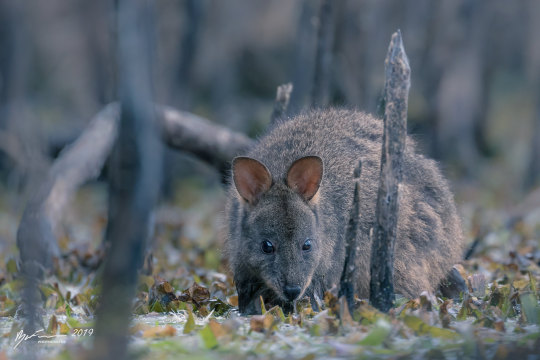
Tasmanian pademelon (Thylogale billardierii)
Photo by Ryan Francis
#tasmanian pademelon#pademelon#thylogale billardierii#thylogale#macropodinae#macropodidae#macropodoidea#macropodiformes#diprodontia#australidelphia#marsupialia#metatheria#mammalia#tetrapoda#vertebrata#chordata
22 notes
·
View notes
Text

Ngl I’m kinda starting to feel bad for our extant marsupials
#memes#thylacine#tasmanian tiger#pademelon#marsupials#animals#funny#lotr#lotr memes#pademelons#conservation#ecology#cryptozoology#cryptid#biology memes
569 notes
·
View notes

